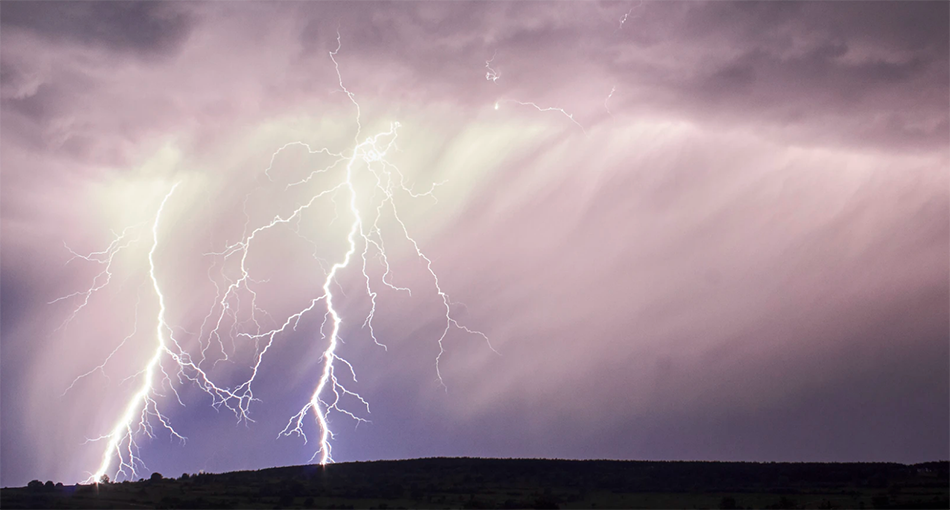When it comes to safety and security, few things are more important than the integrity of the roof over your head. Yet last year alone, severe weather—including heavy rain, hail, and high-speed winds—caused close to $15 billion in damages to homes in the United States alone, accounting for nearly 40 percent of all homeowners’ insurance claims.
Unlike some parts of the country, the Mid-Atlantic region doesn’t often have to deal with the most severe types of weather, like hurricanes and tornadoes. That said, Maryland, Pennsylvania, and the surrounding states are not immune to heavy rains, hail, and high winds, which can be extremely damaging to roofs.
Heavy Rain
An intense downpour or a series of moderate rainstorms can cause severe roof damage. Heavy rain can cause shingles to buckle or curl, especially if they are already showing signs of wear and tear. When shingles are worn down, they begin to deteriorate, making them more likely to break in a rainstorm. And once there is even a small area of your roof exposed, your interior is very likely to incur water damage. Addressing minor issues immediately keeps damage from spreading and ultimately saves you from the cost of more extensive repairs.
Hail
The type and severity of hail roof damage differs according to the type, age, and slope of your roofing material, the size of the hail stone, and the speed and direction of the wind. It may not be a foolproof method for evaluating the likelihood of storm damage to your roof, but knowing the size of the hailstone involved is a good place to start.
¾ inch: Property owners often discount possible roof damage after storms with smaller caliber hail because they underestimate its impact. Depending on the wind speed of the storm, hail as small as ¾ of an inch can cause serious damage to your home’s roof, metal fascia, vinyl siding, gutters and downspouts, and window screens. It can also dislodge granules from asphalt shingles.
1 inch: In addition to damage caused by smaller hail, stones that measure 1 inch can also cause significant bruising to shingle underlayment. Again, wind speeds will determine the severity of damage.
1¼ inch: It’s hard to believe, but just a quarter of an inch more in size makes the potential for hail damage much more significant. Even with minimal wind speed, hail of this size is potentially very damaging to your roof.
1½ inch: Depending on the duration of the storm, the amount of hail, and the speed of the wind, this size hail is almost certain to cause severe damage to your roof.
1¾ – 2 Inch: Hail of this size can actually penetrate plastic vents, ridge caps and other softer roof components. In combination with high winds, hail in this range can wreak havoc on your roof, causing both cosmetic and less obvious but still serious damage.
2” Inch: If your area suffers a storm that brings hail of this size with it, it’s not a matter of whether you will have damage but rather where the damage is. Because it’s difficult to see all the damage your roof may have sustained with the untrained eye, arrange for a professional roof inspection as soon as possible.
Some hail damage is immediately noticeable. For example, it’s easy to spot the broken edges on your shingles or shakes. However, be sure to look carefully near your gutters for less obvious signs of high-impact hail damage. Chances are that if hail was heavy enough to dent your gutters or downspouts, it may have caused damage to the surrounding roof.
When combined with high winds, hail can also cause roofing shakes or shingles to crack, leaving the roof with bare spots. The impact of hail on a roof can shatter the shingle’s surface, causing it to pull away from the underlying mat and exposing the fiberglass. Hail can also fracture the fiberglass mat. Less visible but even more serious, a fractured fiberglass mat seriously compromises the integrity of your roof.
High Winds
High winds can weaken your shingles’ self-seal strip, causing the shingles to blow completely off. Wind damage will often affect the edges of the roof or areas of the roof that have already seen damage/wear. Once it’s ripped off some shingles, it could start a domino effect and pull up other linked shingles.
In addition, high winds, with or without driving rain or hail, often cause more subtle damage to your roof, such as granule loss, punctures, and bruising.
- Granules are the sandpaper-like outer coating of the shingle. High winds can strip the granules from shingles, exposing the asphalt coating to the elements. This degrades the material’s performance, leading to accelerated aging and poor performance. Severe weather can cause shed granules to pile up in your gutters.
- Bruising is the soft, spongy area on or around the spot where shingle granules are missing or displaced. It results when the hail has placed enough pressure on the shingles that the fibers within the mat have loosened and have started to come apart.
Experts in roof evaluation can usually feel divots or indentations in this area that are not apparent to the untrained eye. Because bruising is not outwardly noticeable, you may be tempted to ignore it. However, because bruised areas on your roof are not protected by a thick layer of granules, they are susceptible to future damage from temperature gradations and more.
Unlike other areas of your home, you can’t always see the damage that may have happened to your roof. Yet staying on top of repairs is critically important to its longevity. Following a severe storm, have your roof inspected—especially if you can see debris on the ground or other telltale signs that some roof damage may have occurred out of sight.
Remember that even though there is no tried-and-true way to protect your roof from being damaged by heavy rain, hail, or high winds, a well-maintained roof will hold up better against the element than one that has sustained even minor damage in the past. Don’t ignore even the smallest issues—keeping up with relatively small repairs as they occur is far better than having to replace your entire roof prematurely—or risk damage to the contents of your home.














